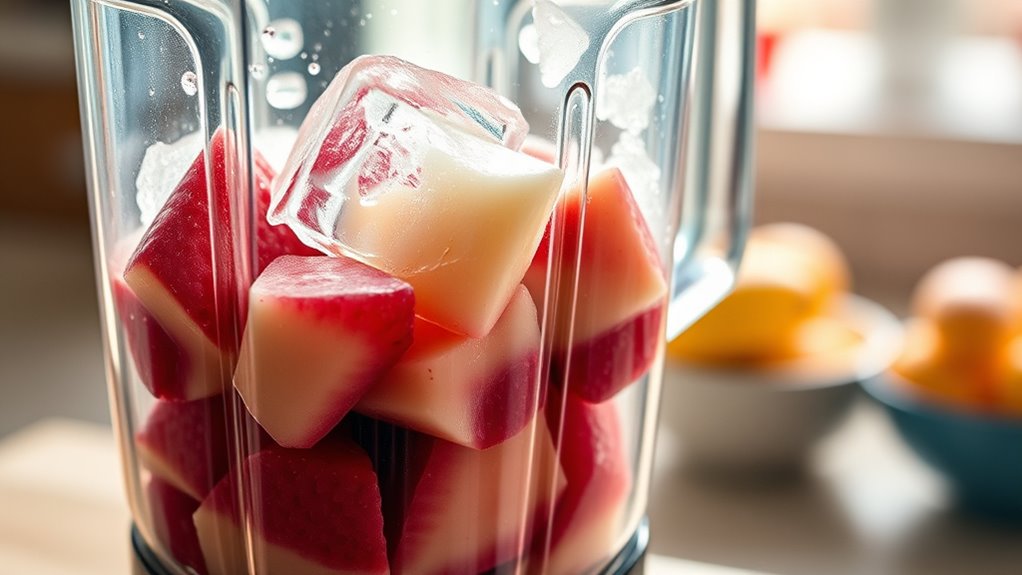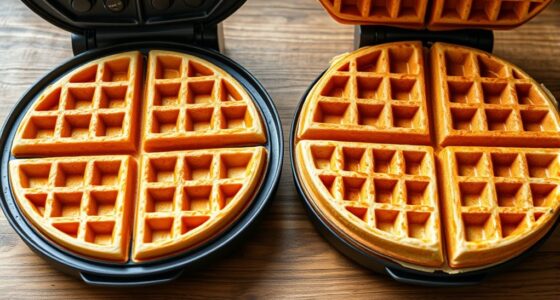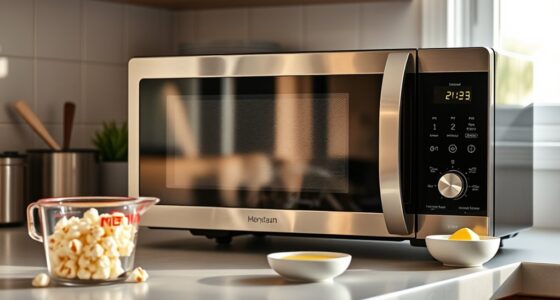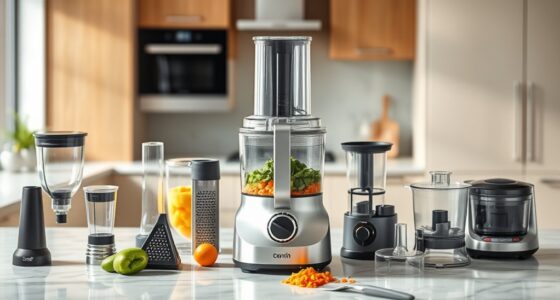The biggest mistake stopping you from making perfect smoothies is using a low-powered blender or overloading it with ingredients it can’t handle. Forcing tough ingredients like ice or frozen fruit into an underpowered machine causes clogs, overheating, and uneven blends. Skipping proper ingredient layers, not adding enough liquid, and ignoring manufacturer guidelines only make things worse. If you keep these pitfalls in mind, you’ll discover how to get consistently smooth, creamy smoothies every time.
Key Takeaways
- Using an underpowered blender or blending frozen ingredients without proper technique causes uneven textures and poor consistency.
- Overloading the blender beyond recommended capacity strains the motor, leading to clogs, overheating, and damage.
- Choosing the wrong blades or not layering ingredients properly reduces blending efficiency and results in chunky smoothies.
- Failing to add enough liquid or neglecting to clean the blender after use hampers performance and causes ingredient sticking.
- Relying on low-wattage blenders for tough ingredients or ignoring manufacturer guidelines compromises smoothness and appliance longevity.
Overloading Your Blender Beyond Its Capacity
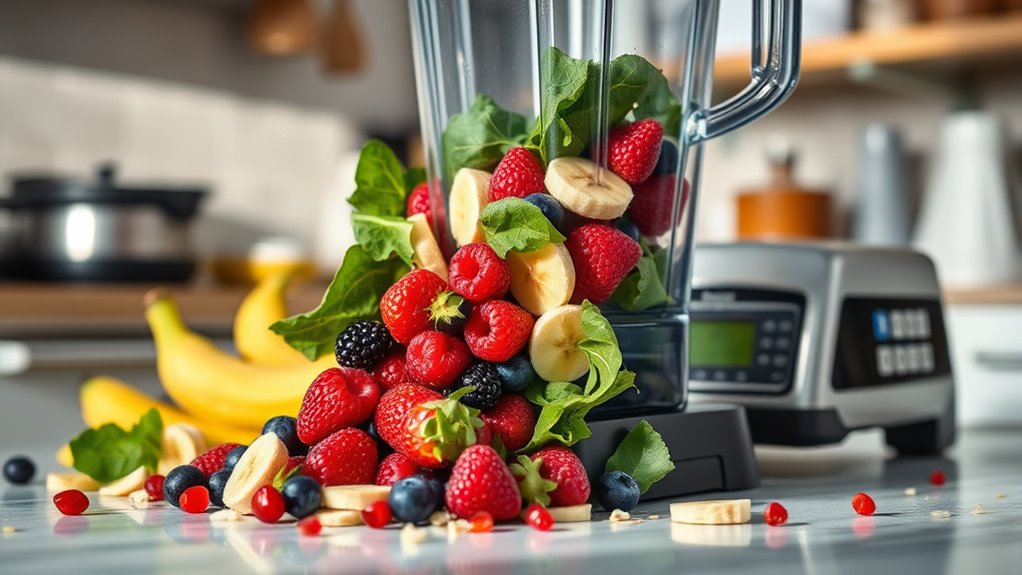
Overloading your blender beyond its recommended capacity can lead to uneven blending and clumps, making it harder to achieve smooth results. When you ignore the blender capacity and add too many ingredients, the blades struggle to move freely, causing inconsistent blending consistency. Overloading also puts unnecessary motor strain on your appliance, increasing the risk of overheating or burning out prematurely. Proper loading involves filling the pitcher within the manufacturer’s suggested limits, ensuring the blades can work efficiently. Filling too high increases the chances of spills, leaks, and damage to internal components. To get the best results, always blend in smaller batches that stay within the blender capacity, which helps protect the motor and guarantees a smoother, more uniform mixture every time. Additionally, understanding the importance of electric horsepower can help you choose the right blender to enhance your blending efficiency. Being aware of blender capacity is essential to avoid common mistakes that compromise performance and longevity. Recognizing the appropriate blender size for your specific needs can also prevent overloading and improve overall results.
Using the Wrong Blades or Attachments for Your Ingredients
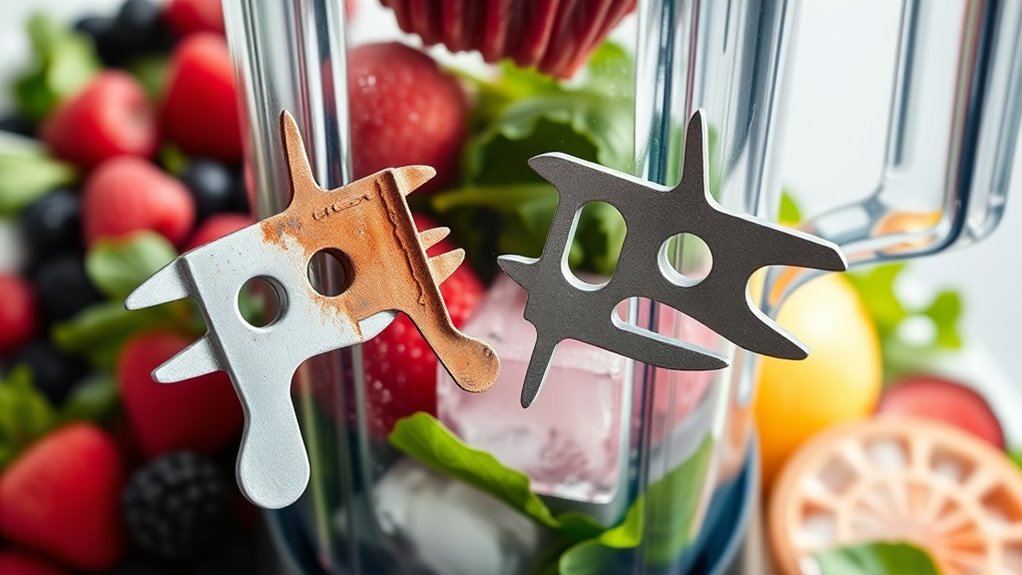
Choosing the right blades or attachments is essential for achieving the best blending results. Using the wrong ones can lead to uneven textures or incomplete blends. Different blades are designed for specific tasks: cross blades are perfect for pureeing, while chopping blades handle tougher ingredients like nuts. Proper attachment selection can also improve energy efficiency by reducing blending time and power consumption. Additionally, using the correct blade type can help prevent blender damage, extending the lifespan of your appliance. Selecting the appropriate blades also ensures ingredient preservation, maintaining the nutritional quality of your blends. The right blades can also influence cleaning and maintenance, making your blender easier to clean after use. Incorporating the proper blades can also promote consistent results, making your smoothies smoother and more enjoyable.
Skipping the Proper Ingredient Order for Optimal Blending
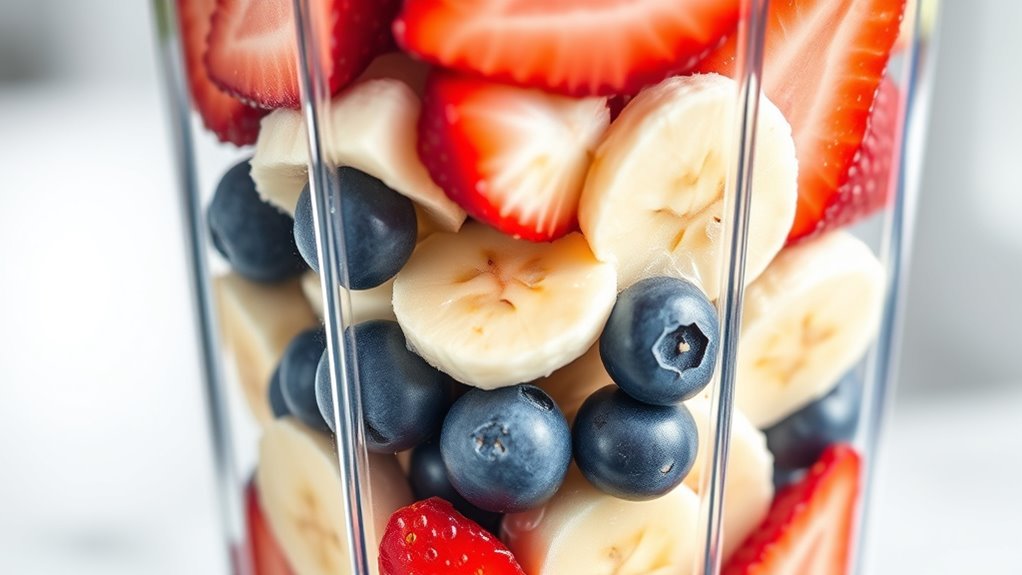
Properly arranging ingredients in your blender can make a significant difference in the final texture and consistency of your blend. The right liquid order and ingredient layering promote efficient blending and a smoother smoothie. Start by adding liquids at the bottom to create a vortex that helps circulate ingredients evenly. Proper ingredient placement, like placing soft greens or powders above heavier items, prevents clumping and ensures thorough mixing. Adding frozen fruit last maximizes blending momentum, reducing sticking and blade clogging. This blending technique minimizes air pockets and prevents stalls, resulting in a more uniform smoothie consistency. Using the correct storage methods for ingredients can also help maintain their freshness and blendability. Additionally, understanding ceiling fan efficiency can inspire better kitchen appliance management, such as optimizing blender performance. Employing proper ingredient layering techniques can significantly enhance your blending results. Skipping this step or neglecting proper ingredient order can lead to uneven textures or the need for manual stirring. Mastering proper ingredient placement is essential for achieving the best possible blend every time. For example, Hyundai Tuning principles emphasize precise modifications and proper setup, which can be analogous to fine-tuning your blending process for optimal results. Being aware of food preservation techniques can help ensure your ingredients stay fresh and easy to blend, preventing unnecessary texture issues.
Not Adding Enough Liquid to Achieve a Smooth Texture
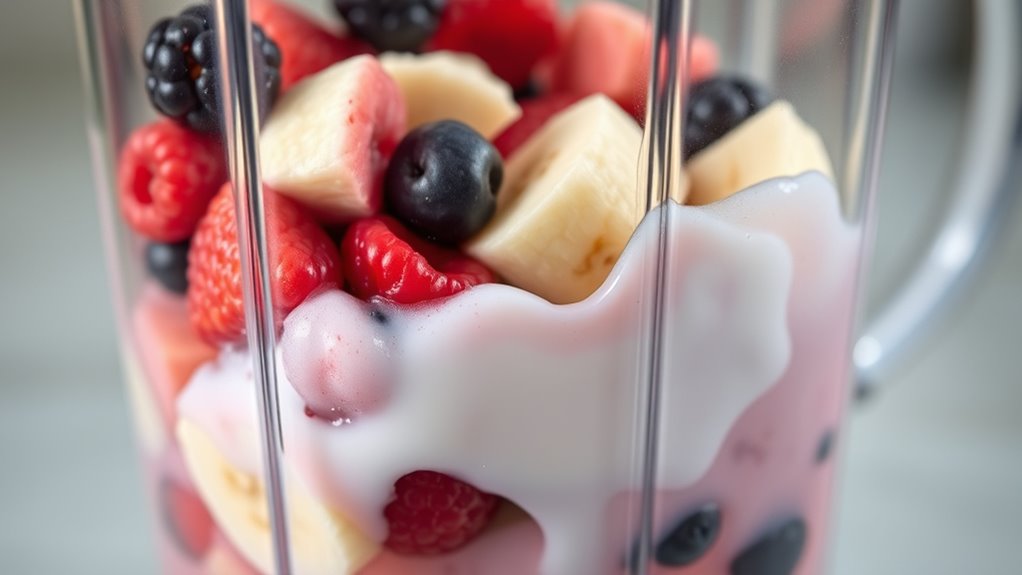
If you don’t add enough liquid, your blender struggles to process the ingredients smoothly. Without enough liquid, ingredients stick to the sides of the blender, causing uneven blending and lumps. The motor also strains as it tries to blend thick mixtures, risking overheating or burnout. Using a proper ratio, like 250ml of liquid per 150g of frozen fruit, helps attain a smooth, consistent texture. When liquids are insufficient, the blades can stall or jam, making it difficult to get that creamy, uniform smoothie you want. Plus, a lack of liquid reduces nutrient extraction and results in a denser, less palatable final product. Ensuring the right balance supports AI-enhanced processing for optimal nutrient release and consistency. Incorporating robust safety measures can prevent overheating or motor failure during blending. Proper beneficial ratios of liquid to solids are essential for achieving the best results and avoiding strain on your blender. To avoid these issues, always confirm you’re adding enough liquid to support efficient blending and ideal smoothie texture. Maintaining proper toilet size and comfort can also help prevent unnecessary strain on your blender by ensuring your ingredients are prepared correctly. Kia Tuning can improve your vehicle’s performance, but blending requires the right liquid balance for optimal results.
Attempting to Blend Frozen Items Without a High-Powered Machine
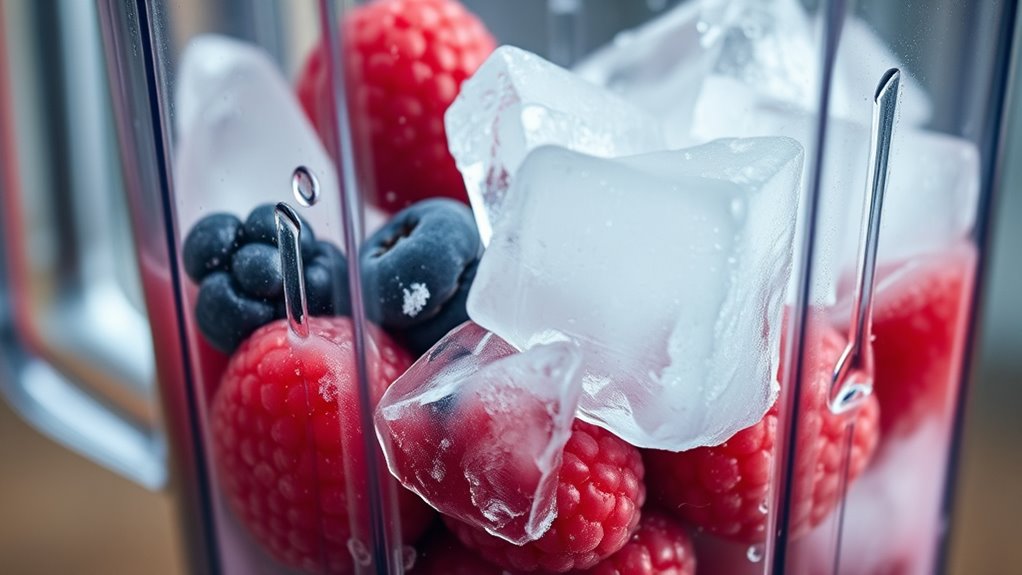
Trying to blend frozen ingredients with a low-powered blender often leaves you with clumped textures and uneven results. These machines struggle to crush ice and frozen fruit, which can cause blades to stall or jam, risking damage. Without enough power, you’ll end up with a watery or gritty smoothie instead of the creamy consistency you want. Ensuring your blender is equipped with a suitable motor and tip size can make a significant difference in handling frozen items effectively.
Blenders Struggle With Ice
Blenders often struggle with ice because most lack the motor power needed to crush frozen ingredients effectively. Without a high-powered blender, you risk uneven textures, blade jams, or motor strain. Standard blenders can’t handle large or hard ice cubes, leading to frustration and potential damage. Using the wrong settings or low wattage models worsens the problem, producing slushy results instead of smooth ice. To improve ice crushing, consider these points:
- High-powered blenders excel at ice crushing with designated pulse functions
- Lower wattage models often jam or stall when faced with frozen ingredients
- Blade design impacts ability to break down ice efficiently
- Attempting to blend frozen items risks overheating and motor wear
- Proper technique, like gradual speed increase, helps prevent damage
Choosing the right blender for ice crushing ensures your smoothies stay smooth and perfect every time.
Damage From Frozen Ingredients
Attempting to blend frozen ingredients with a low-powered blender places excessive strain on the motor, often leading to overheating or complete burnout. The high resistance from frozen ingredients causes motor strain, risking blender damage and reducing its lifespan. Without a high-powered machine, blades struggle against ice and frozen fruit, which accelerates blade wear and dulls cutting edges over time. Forcing frozen ingredients into a weak blender can also cause clogs or overheating, potentially resulting in motor failure that requires costly repairs or replacements. Repeatedly blending frozen items in an underpowered device compromises its performance and durability, leading to inconsistent textures and poor smoothie quality. Avoid this mistake to protect your blender and guarantee smooth, perfectly blended results every time.
Power Limits Affect Results
Using a low-powered blender to process frozen ingredients often leads to uneven textures and frustration. When your blender lacks sufficient motor capacity, it struggles to crush frozen fruit, resulting in chunky, inconsistent smoothies. Pushing a weak blender too hard can cause overheating, motor burnout, or blade damage, making blending mistakes more likely. For smooth and creamy results, a high-powered blender (above 1000W) provides the torque needed to handle frozen items effortlessly.
- Insufficient blender power results in longer blending times
- Frozen fruit remains chunky and uneven
- Overloading can damage the motor or blades
- Achieving the desired smoothie texture becomes difficult
- Poor results lead to frustration and repeated attempts
Ignoring Manufacturer Guidelines and Safety Features

Ignoring manufacturer guidelines and safety features can lead to serious problems during blending. When you neglect the manufacturer’s instructions, you risk overfilling the blender, which causes inefficient blending and can burn out the motor. Failing to use safety features like locking lids increases the chance of spills, injuries, and damage to the appliance. Not following proper usage, such as selecting incorrect blending cycles or ignoring ingredient compatibility, can result in uneven textures and damage blades or components. Additionally, overlooking recommended blender maintenance and cleaning protocols shortens its lifespan and hampers performance. To avoid these blending mistakes, always adhere to the manufacturer guidelines, utilize safety features, and follow proper usage and maintenance routines. This ensures your blender works smoothly and produces perfect smoothies every time.
Failing to Clean Your Blender Immediately After Use
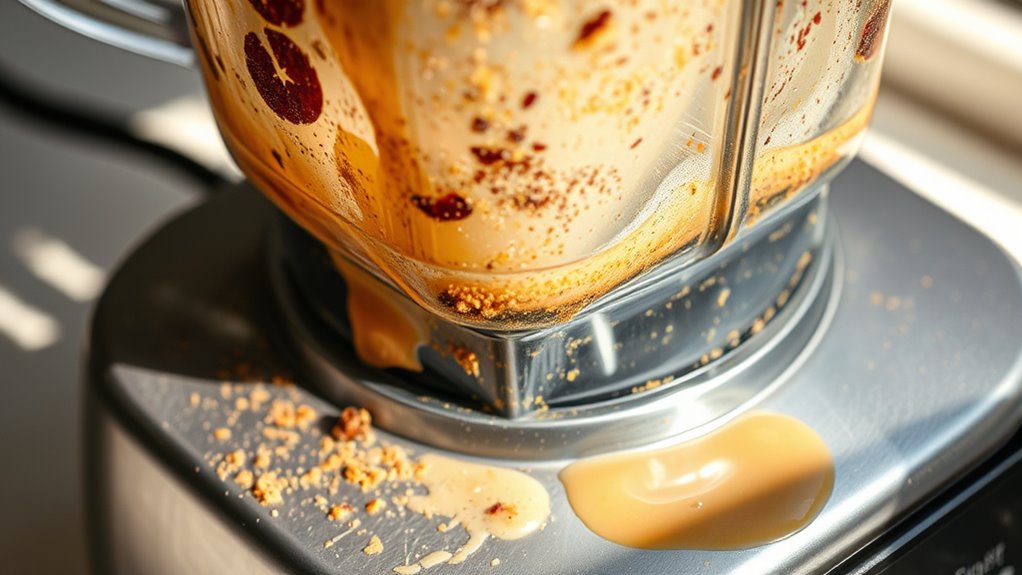
Failing to clean your blender immediately after use can lead to stubborn residue that’s much harder to remove later. When ingredients dry or harden, cleaning becomes more time-consuming, and stubborn stains can set in. Immediate cleaning helps prevent residue buildup, which can impact both the flavor and texture of your future smoothies. Plus, neglecting prompt cleaning creates hygiene risks, as bacteria and mold can develop in leftover food particles. Regularly rinsing and scrubbing right after blending maintains your appliance’s freshness and appearance. It also extends the lifespan of your blender components by preventing material corrosion and mold growth.
- Prevents stubborn stains and odors
- Keeps your blender hygienic and safe
- Reduces cleaning time later
- Protects appliance longevity
- Ensures better-tasting smoothies
Relying on a Low-Powered Blender for Tough Ingredients
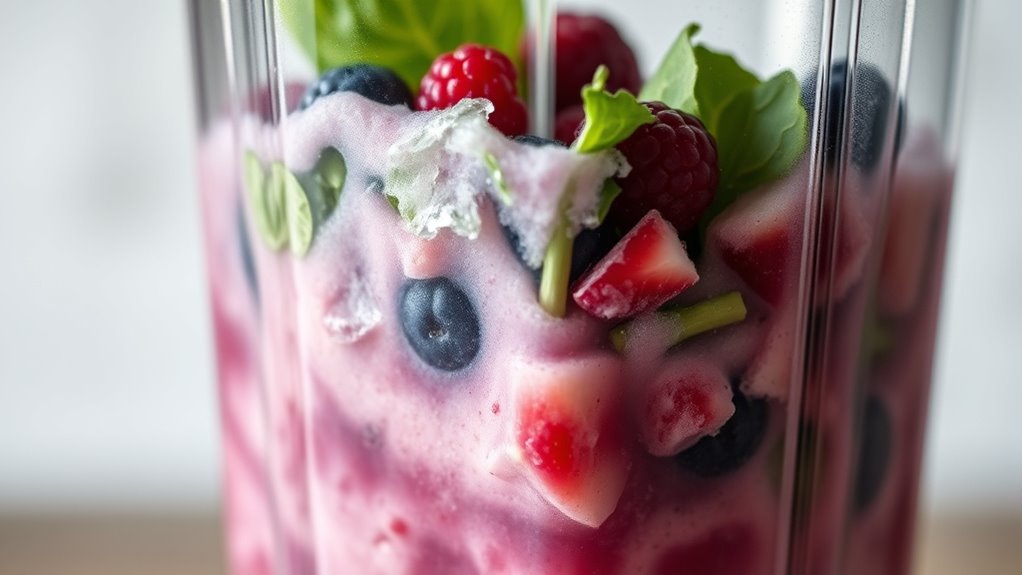
Relying on a low-powered blender to handle tough ingredients can lead to frustrating results and potential damage to your appliance. These blenders, with motor wattages below 600W, struggle with blending tough ingredients like ice, frozen fruits, or fibrous greens, resulting in uneven textures and chunks. You’ll find yourself spending extra time blending, but the smoothie consistency still won’t be smooth. Pushing a low-powered blender too hard can cause the motor to overheat or burn out, risking costly repairs. Instead, investing in a higher-powered blender with 800W or more guarantees you get consistent, creamy smoothies with less blending time. Don’t compromise quality or your blender’s lifespan—use the right tool for tough ingredients to achieve perfect results every time.
Frequently Asked Questions
What Is the Rule 3 for Smoothies?
The Rule 3 for smoothies is your go-to guide for perfect blends. You use 3 parts frozen fruit, 1 part liquid, and 1 part thickener or add-ins. This balance helps you avoid watery or overly thick smoothies, ensuring a smooth, creamy texture every time. Stick to this ratio, and you’ll find it easier to customize ingredients while maintaining great taste and consistency in your smoothies.
What Fruits Should Not Mix in a Smoothie?
Did you know that mixing certain fruits can ruin your smoothie? You should avoid combining citrus with dairy, as it causes curdling, and melons with other fruits, which leads to separation. Bananas don’t blend well with acidic fruits like pineapples or strawberries. Watermelon with dense ingredients like nuts can also cause texture issues. Stick to compatible fruit pairings for smooth, delicious results every time.
How to Get Perfect Smoothie Consistency?
To get perfect smoothie consistency, start by placing liquids at the bottom of your blender to create a vortex that pulls ingredients down. Layer softer fruits before tougher ones, and add frozen ingredients last to keep blades moving smoothly. Blend on low initially, then ramp up speed gradually. Don’t overfill, as that can cause uneven texture, and guarantee all ingredients are evenly distributed for a smooth, creamy result every time.
What Type of Blender Is Best for Making Smoothies?
When choosing the best blender for smoothies, you want one with a powerful motor, ideally 1,000 watts or more, to handle ice and frozen fruits effortlessly. High-speed blenders like Vitamix or Blendtec are perfect because they deliver ultra-smooth results quickly. If you prefer something budget-friendly, look for models with pulse and ice-crushing settings. A larger jar and sharp blades also help achieve the best, creamy smoothies every time.
Conclusion
If you keep making these blender mistakes, your smoothies will forever be chunky, lumpy disasters instead of silky perfection. It’s like trying to shave with a butter knife—frustrating and pointless. Stop overloading, choose the right blades, and follow the guidelines, or you’ll never taste that smooth, creamy goodness you crave. Fix these errors today, and transform your blending game from a culinary catastrophe into a smoothie masterpiece every time!
